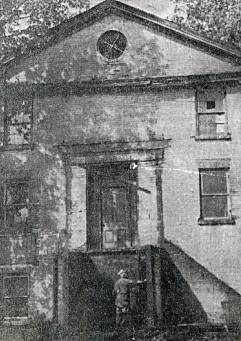The Wesleyan Methodist Church: Ingersoll’s Haven for People Escaping Slavery
The Wesleyan Methodist Church: Ingersoll’s Haven for People Escaping Slavery
By Megan Lockhart, Archives Technician
In celebration of Black History Month, our blog articles this month will be focused on the history of the Black community in Oxford County. Today I'm delving into the history of a local church that was a significant site related to the Underground Railroad.
The Wesleyan Methodist Church was built on the west side of Oxford Street (now 110 Oxford St.) in Ingersoll, Ontario in 1854. It was physically constructed through volunteer labour, Ingersoll residents who had been formerly enslaved before fleeing to Canada volunteered their skills and time to help build the church. Many local Black residents had valuable construction skills, such as bricklaying and roofing. The church had a capacity for around 500 people; the minister's living quarters were located on the top floor. The church was most notably a safe haven for people escaping slavery. Assisted by Quakers who held strong anti-slavery beliefs, Black people were fleeing to Southwestern Ontario from plantations in the American South, even from as far as New Orleans, Louisiana. Having to work under the protection of darkness, people escaping slavery were secretly smuggled into the attic of the Wesleyan Methodist Church at night. The church was a well-known terminal of the Underground Railroad. Some people arrived in Ingersoll by stagecoach from Port Burwell, Ontario; an operation run by abolitionist Harvey C. Jackson. Ingersoll locals who condemned slavery provided employment opportunities for freed people on nearby farms.

The former Wesleyan Methodist Church in Ingersoll, Ontario. The photo was taken by Stanley J Smith in 1956. Courtesy of the Ingersoll Public Library.

A view of Oxford Street in Ingersoll, Ontario, circa the early 1900s. [J. Gruszka PC 0171]
A number of famous individuals spoke at the church, including abolitionist John Brown in 1858. Amelia Webster was also a famous speaker at the church. Webster had spent months in an American prison in the South, charged with teaching enslaved people how to read and write. The church choir included many local Black residents.

Portraits of American abolitionist John Brown. Courtesy of Wikimedia Commons.
The church no longer provided religious services after 1865, when the Wesleyans moved to another location on King Street. The building was, however, the first public building in Ingersoll to be lit by electricity. After its closure as a church, the building housed a number of local businesses. Today, the building is no longer standing.
